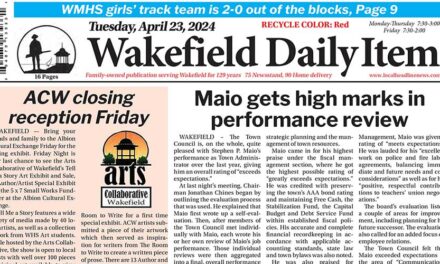By DAN TOMASELLO
LYNNFIELD — The designs for the Lynnfield Center Water District’s two capital improvement projects are continuing to progress, Superintendent John Scenna said during a recent Board of Water Commissioners meeting.
Ratepayers approved the LCWD’s $9.8 million capital improvement projects during the May 2021 Annual Meeting. The first component of the project entails connecting the LCWD system with the town of Wakefield’s at the Main Street and Bay State Road intersection. The interconnection project will allow the LCWD to get supplemental water from the Massachusetts Water Resource Authority (MWRA) via Wakefield.
Wakefield DPW Director Joe Conway told the LCWD Board of Water Commissioners at a recent meeting that the Lynnfield Conservation Commission approved Wakefield’s Notice of Intent request to install 1,910 feet of new water main at the intersection.
“Everything went as expected,” said Conway. “The Massachusetts Department of Transportation has also delivered a right-of-way permit for construction. We are good to go.”
Conway said the Wakefield DPW hopes to begin construction this fall.
“There are some I’s that have to dotted and some T’s that have to be crossed by my staff and John’s staff,” said Conway. “We should have all of that wrapped up by September. We are hoping for fall construction, but it could be pushed to next April at the latest.”
Scenna said he has developed a cooperative working relationship with Conway and Wakefield DPW officials over the past year-and-a-half.
“I feel that this project not only benefits the Lynnfield Center Water District, but also benefits the town of Wakefield,” said Scenna. “Joe can now move forward with his contractors to finalize proposals to purchase pipes, but there are supply chain issues involved. He and I are going to work with the town of Lynnfield to develop a tri-party agreement, which will allow Wakefield pipes to come into Lynnfield roads. Once that is agreed upon, we will formally execute the inter-municipal agreement that we agreed to a year ago.”
CDM Smith Project Manager Anne Malenfant said the interconnection project involves constructing an underground vault that will connect both water systems.
“This will be the LCWD’s fifth water source,” said Malenfant.
Malenfant said the vault will be located under a grass parcel located by the Route 95/128 ramps off Main Street.
“The original intent was to locate it in the MassDOT right-of-way,” said Malenfant. “It was going to be very challenging to construct the vault there due to excavation. That is why we decided to move it. It’s the same design, but construction will be easier.”
Scenna said moving the vault’s location will save the LCWD money.
“The vault is large and has to be installed with a crane,” said Scenna. “It’s very hard to do that when there are transmission wires overhead.”
Malenfant said the vault will have a meter that will be used to control the amount of water the district is bringing in from Wakefield. She said the goal is to have the vault component of the project go out to bid in January 2023.
“We are looking to start construction next spring or summer,” said Malenfant.
In order for the LCWD to receive water from the MWRA, Malenfant said the Water Resources Commission (WRC) will be reviewing the project as required by the Interbasin Transfer Act (ITA).
“The Water Resources Commission is made up of multiple governmental agencies to cover all of the different requirements for the Interbasin Transfer Act,” said Malenfant.
After the WRC signs off on the interconnection project, Malenfant said the MWRA Board of Commissioners, the State Legislature and the governor will need to approve it as well. Due to the extensive environmental review requirements involved in the process, she anticipates that the WRC will vote on the ITA request in February 2024.
Malenfant anticipates the LCWD’s application to join the MWRA will formally be submitted in March 2024, and will be accepted in early 2025. The timeline seeks to have the LCWD start receiving supplemental water from the MWRA by the summer of 2025.
“We have been coordinating with the WRC and the MWRA to get them the initial information they are looking for in this process,” said Malenfant.
Scenna acknowledged that the lengthy timeline for joining the MWRA is “frustrating.”
“By meeting with different agencies initially, we got the answers to the test before we take it,” said Scenna. “We know the questions that are coming and what they want to see. We have been essentially told to give them all of the information at once so it will make the process a little shorter. As frustrated as I am with the process today, it would be even more frustrating to have the infrastructure in place and not be able to draw from it.”
In response to a question from Water Commissioner Andy Youngren, Malenfant said the WRC wants to make sure the LCWD absolutely needs water from the MWRA.
“They WRC very much prefers not having water move from one basin to another,” said Malenfant. “They want to make sure the water system has done everything possible to maximize current water sources, and this is the only path forward. We have gone through this process in other communities, and we know what to look for and what the WRC wants.”
Youngren recalled that the ongoing drought has resulted in the LCWD implementing Level 5 restrictions, which prohibits outdoor watering.
“We are in dire straights right now,” said Youngren. “Is there any way we can streamline this process to make it happen faster?”
Malenfant said LCWD and CDM Smith officials are “doing everything” they can to “condense the timeline.”
“When it comes to the WRC review period, they have set required time periods that have to be followed,” said Malenfant.
Water treatment plant
Malenfant noted that the capital project also includes constructing a $6.3 million greensand filter water treatment plant at Station 4 on Glen Drive. She said the new treatment plant will be used to treat iron and manganese, which has caused discolored water problems that have impacted a number of ratepayers.
“From the existing pump station, the water will be pumped through the greensand filters and will go out to the distribution system,” said Malenfant.
Malenfant said CDM Smith began designing the greensand filter treatment plant last fall when LCWD officials learned that the six per- and polyfluoroalkyl substances called PFAS6 tested at Station 2 on Main Street surpassed MassDEP’s requirement be 20 parts per trillion (PPT). The maximum contaminant level (MCL) equals one drop of water in 20 Olympic-size swimming pools.
While the LCWD will be using two AVANTech vessels to treat PFAS as a short-term solution, Malenfant said CDM Smith decided to incorporate a separate PFAS treatment facility into the new Glen Drive treatment plant’s proposed design. She said additional funding opportunities such as grants from the Environmental Protection Agency could be used to finance this component of the water treatment plant project.
Malenfant said CDM Smith and LCWD officials are examining other possible permanent solutions for treating PFAS6, but no final decision has been made.
“If there is no additional funding opportunities or one of the other PFAS mitigation alternatives is selected, that building can be removed from the design and Glen Drive can return to just iron and manganese removal,” said Malenfant. “But if funding is secured and the decision is made to treat both at Glen Drive, it can be combined into a single design. There are a lot of moving parts right now.”
Malenfant said the greensand filter component of the Glen Drive project has reached its 60 percent design while the PFAS component of the project has reached the 30 percent design.
“We anticipate reaching the 90 percent design by December and submitting the final design in March,” said Malenfant.
Malenfant anticipates the new Glen Drive water treatment plant will be on line by early 2025.




